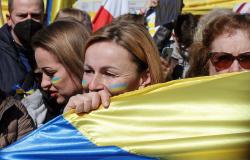How Local Women Mobilizers Shaped Ukraine’s Invasion Response

Esther Brito Ruiz on how the situated knowledge and networks of local women can create more resilient, tailored, and effective responses in the face of complex emergencies.
The impacts of Russia’s war in Ukraine have been deeply gendered: from human traffickers targeting women and children fleeing airstrikes, to the increase in gender-based violence, rising feminized poverty, and haunting testimonies of sexual violence.
Yet despite these disproportionate vulnerabilities, Ukrainian women have also emerged as vital agents of resistance: as fighters, political leaders, aid providers, and more.
The role that women-led civil society organizations have played in this response has been widely acknowledged by the humanitarian community – transforming and expanding their operations to lead relief efforts, shape emergency governance responses, document atrocities to support prosecution efforts, and provide both direct and operational support to military engagement.
But there has been less discussion of the role that individual citizens have played in shaping the response.
I recently led a study on the efficacy and impact of a series of women’s empowerment programs run in the eastern provinces of Ukraine between 2018 and 2022. Throughout conversations with more than 30 aid providers across the country, one impact more than any other came up repeatedly: how women who had participated in these programs had emerged as significant local mobilizers in the aftermath of the 2022 invasion, guiding and advising authorities on the emergency response and social protection efforts.
This was not what the programs had initially been designed to achieve. But was a fortuitous and unexpected consequence of their design - and one that can teach humanitarian actors important lessons about the value of engaging and being led by not just local organizations, but local citizens.
Building Women-led Local Governance Structures
Over the last decade, Ukraine has worked to make its governance structures more localized, transparent and inclusive, shifting responsibility and power from the national level to the local one. As part of these reforms, over 15 local governments have partnered with international donors on a range of initiatives designed to make their practices and policies better meet the needs of women and girls, from police education on gender-based violence, to the creation of Local Gender Coordination Councils, which bring together local gender advocates to advise on local government policies and programming, and Self-help Groups, through which groups of women work together to directly address challenges facing their communities, including childcare, food security, and racial and ethnic discrimination.
These programs operate both as advisory working groups, seeking to review and assess the gendered implications of local government policy, and as mobilizers - advocating for and responding to the needs of minority, internally displaced, and conflict-affected women. Many took place in areas that have been struggling with the effects of conflict for years, in some cases since 2014, when Russia invaded and subsequently annexed the Crimean peninsula.
Even before the war, these groups had already yielded over one hundred policy recommendations across more than 25 local government areas. But it was after the full-scale invasion began in February 2022 that their impact really came into full effect, as the women who participated in these programs rose up as vital local experts and community mobilizers.
A Bottom-up Disaster Response
In the years prior to the invasion, women in these groups had connected locally with vulnerable residents and built-up networks assessing their needs. They established deep, situated knowledge on the demographics and differential aid requirements in their communities, helping coordinate support during the pandemic for those further at risk – including elders, the disabled, and mothers with small children.
When the war broke out, local governments – often small, rural, and with limited means – struggled to devise rapid emergency responses in the wake of airstrikes, food shortages, and energy cuts. But the women mobilizers who had been working so closely with the local community knew exactly how and where help was needed. Their networks were repurposed and became the core paths to secure provisions and communicate with service providers – for example, helping provide formula for mothers who were unable to nurse and wheelchairs for urgent mobility needs. They became prime first responders, able to assess, guide, and coordinate vital support.
Beyond this, the knowledge these women had built as advisors and community mobilizers also helped humanitarian partners and local authorities shape their longer-term rescue and protection efforts. Larger aid providers leveraged their expertise to develop critical policy recommendations and diagnostics – tracing key developments in affected communities and dramatically improving the effectiveness of public response in the months following the war’s escalation. Collecting data, documenting evidence, and leveraging their experience, these women became critical knowledge providers for international partners and local institutions.
When these women became displaced themselves – some for the second time, given prior disruptions the Donbas region had faced for years – they utilized their training to support others in navigating government services and connecting with institutional support. More than that, they started creating their own groups and mobilizing other women in the sites they relocated to.
Leveraging the Knowledge and Networks of Community Mobilizers
People like these women exist in every community: motivated organizers and connectors with the deep local knowledge about their community needs and the skills and ambition to make those ideas a reality. What these programs did was provide a channel first to access their insights, and then to foster the networks - both within their local communities, and with government instruments and humanitarian aid sector - needed to bring those ideas to fruition.
When the war broke out, it was not local governments that were reaching out to these women, seeking their knowledge and insight on how to direct the emergency response. It was these local women mobilizers who were leveraging their connections with both the local governments and with their international partners, both institutionally and informally, to make sure humanitarian aid providers knew what was needed and direct the humanitarian response.
Although the original programs were developed with a top down design, the women then took the skills and networks they developed and used them to meet the needs of their community in crisis.
For humanitarian actors looking to better engage the leadership and insights of impacted communities, it offers a useful case study of how the situated knowledge and networks of local women, supported by the resources and perceived legitimacy of international humanitarian organizations can create more resilient, tailored, and effective responses in the face of complex emergencies.
In recognizing the role of these local mobilizers, and investing in resourcing and building relationships with them well before a crisis hits, humanitarian actors can build the long-term networks and infrastructure they need to respond to emergencies more quickly, effectively, and in ways that are better aligned to communities’ true needs.
Esther Brito Ruiz is a Researcher at Global Insight, specializing in multi-methods research and evaluation on gender and conflict. She has worked on projects operating in the United States, Ukraine, Somalia, and Ethiopia, among others, and serves as an Adjunct Professor at American University.
Photo by Nati

